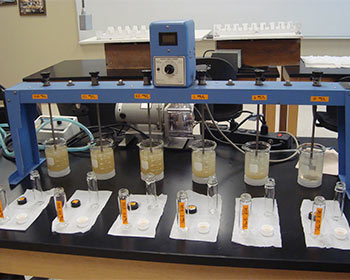

MPC Research Reports |
| Title: | Using Flocculation to Reduce Turbidity of Construction Site Runoff |
| Authors: | Guanghui Hua and Jacob Humburg |
| University: | South Dakota State University |
| Publication Date: | Jun 2020 |
| Report #: | MPC-20-418 |
| Project #: | MPC-436 |
| TRID #: | 01751956 |
| Keywords: | construction projects, flocculating agents, polymers, recommendations, runoff, turbidity, water quality management |
 Construction of highways usually requires large areas of land disturbance, which may result in accelerated soil erosion. The stormwater runoff from highway construction sites typically contains a large amount of fine particles that are difficult to remove using conventional best management practices. Stormwater with high turbidity levels can negatively affect the water quality of receiving waters and natural habitats of rivers, lakes, and streams. Flocculation with polyacrylamide (PAM) is a promising technology that can be used to reduce the turbidity levels in construction site runoff. The objectives of this study were to determine the effectiveness of different PAMs in reducing turbidity of construction site runoff in South Dakota, and to provide recommendations on PAM applications for stormwater runoff treatment. Four different soils were collected from active construction sites in South Dakota and synthetic runoff was created for each soil. Laboratory flocculation experiments were conducted to evaluate various factors that can affect turbidity reduction from synthetic runoff. The results showed that PAM flocculation effectively reduced turbidity from synthetic runoff. PAMs with higher charge densities and molecular weight generally performed better than PAMs with lower charge densities and molecular weight. The optimum polymer dose was approximately 1 mg/L for anionic PAMs. Cold temperatures negatively affected the PAM flocculation of soil solutions, especially at low dosages. PAM flocculation efficiency increased with increasing mixing intensity, mixing time, and settling time. High calcium and low pH conditions improved PAM flocculation. It is recommended that lab testing of specific soil samples should be performed to determine the optimum PAM type and dosage for construction site runoff treatment. For stormwater runoff treatment under cold temperatures, the PAM dose can be increased to compensate for the loss of flocculation efficiency. Adequate mixing and settling conditions should be provided when using PAM for construction site runoff treatment.
Construction of highways usually requires large areas of land disturbance, which may result in accelerated soil erosion. The stormwater runoff from highway construction sites typically contains a large amount of fine particles that are difficult to remove using conventional best management practices. Stormwater with high turbidity levels can negatively affect the water quality of receiving waters and natural habitats of rivers, lakes, and streams. Flocculation with polyacrylamide (PAM) is a promising technology that can be used to reduce the turbidity levels in construction site runoff. The objectives of this study were to determine the effectiveness of different PAMs in reducing turbidity of construction site runoff in South Dakota, and to provide recommendations on PAM applications for stormwater runoff treatment. Four different soils were collected from active construction sites in South Dakota and synthetic runoff was created for each soil. Laboratory flocculation experiments were conducted to evaluate various factors that can affect turbidity reduction from synthetic runoff. The results showed that PAM flocculation effectively reduced turbidity from synthetic runoff. PAMs with higher charge densities and molecular weight generally performed better than PAMs with lower charge densities and molecular weight. The optimum polymer dose was approximately 1 mg/L for anionic PAMs. Cold temperatures negatively affected the PAM flocculation of soil solutions, especially at low dosages. PAM flocculation efficiency increased with increasing mixing intensity, mixing time, and settling time. High calcium and low pH conditions improved PAM flocculation. It is recommended that lab testing of specific soil samples should be performed to determine the optimum PAM type and dosage for construction site runoff treatment. For stormwater runoff treatment under cold temperatures, the PAM dose can be increased to compensate for the loss of flocculation efficiency. Adequate mixing and settling conditions should be provided when using PAM for construction site runoff treatment.
Hua, Guanghui, and Jacob Humburg. Using Flocculation to Reduce Turbidity of Construction Site Runoff, MPC-20-418. North Dakota State University - Upper Great Plains Transportation Institute, Fargo: Mountain-Plains Consortium, 2020.